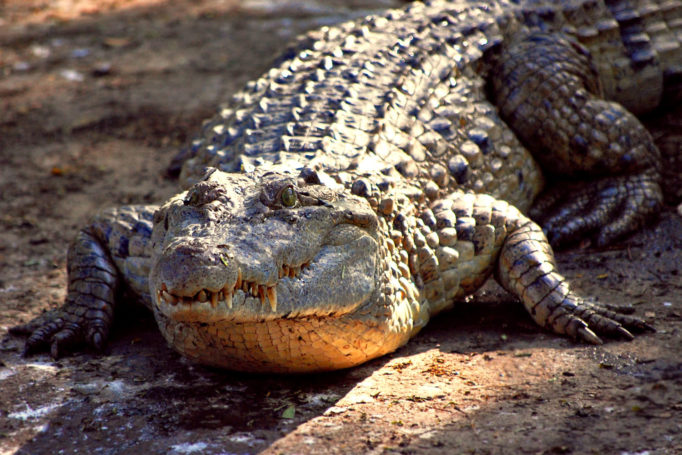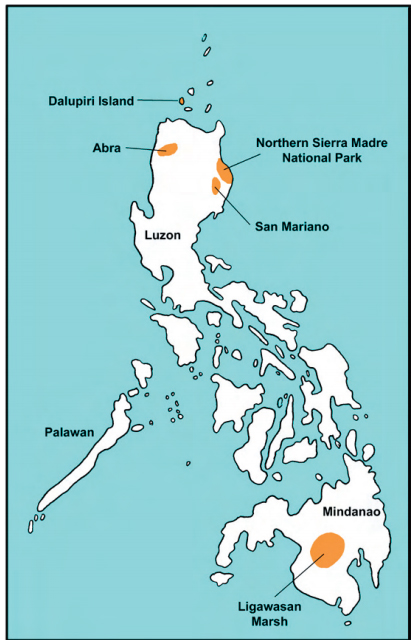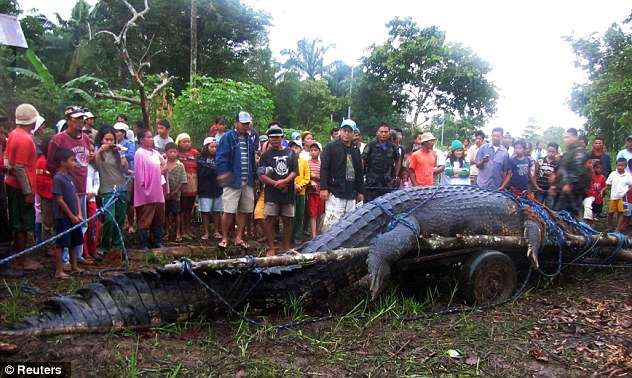There are two crocodile species found in the Philippines – the Crocodylus porosus and the Crocodylus mindorensis. The latter is the specie endemic to and found only in the Philippines. Crocodiles are called “Buwaya” in the Philippines. However, it is used interchangeably to mean either crocodile or alligator. The word “Buwaya” originates from the Proto-Austranesian word “Buqaya.”
A. CROCODYLUS POROSUS is the larger Indo-Pacific crocodile specie, a saltwater, marine crocodile. The saltwater crocodile, found in the Philippines and other Asian countries, is considered the world’s largest reptile. An adult saltwater crocodile normally measures around 20-23 feet long, and weighs about 2-3 tons. FilipiKnow.net reports that a 27-footer saltwater crocodile was killed in Laguna de Bay in 1823. It took 40 men to bring the crocodile ashore. When the crocodile’s body was cut open, the body of a horse was found in seven pieces. The largest ever sighted was a 33-footer crocodile in Borneo in 1920. It was believed to be 200 years old. In September 2011, a 20.24-footer Crocodylus porosus was captured in Agusan del Sur in Mindanao, and was named “Lolong.” The Guiness World Records classified “Lolong” as the largest reptile in captivity. The previous holder was a 17.97 footer crocodile held captive in Australia.
FilipiKnow.net also cites that in Jose Rizal’s novel, Noli Me Tangere, crocodiles are portrayed as vicious sea monsters that could overturn boats with just a flip of their tail. Morever, in Philippine folklore, local crocodile hunters believe these reptiles serve as catch basins of ancestral spirits. To them, the nature and symbolism of saltwater crocodiles is determined by color. Black crocodiles are the fiercest; white ones are rare and considered as lucky omens; while green, yellow, and red crocodiles hold the middle spirits. They believe crocodiles are connected to the afterworld because of its association to water.
Prior to 1990, Crocodylus porosus were found in Mindoro and Busuanga. A reported nest of a palustrine wetland crocodile on Palawan (Schultze 1914) most likely was a Crocodylus porosus as it contained 30 eggs that were all larger than the largest Crocodylus mindorensis wild eggs. In the Ligawasan Marsh (Pomares et al. 2008) and in the coastal wetlands of Isabela in Luzon, the Crocodylus mindorensis and the Crocodylus porosus appear to occur sympatrically, as they occupy the same range but maintain identity by not interbreeding.
B. CROCODYLUS MINDORENSIS is the smaller specie, and called the Philippine Crocodile. It is also known as the Crocodile of Mindoro, a freshwater crocodile locally called Bukarot. Karl P. Schmidt named and described it in 1935. It has a broad snout, wide and thick bony plates, grows to a length of 4.9 feet, and weighs about 33 lbs. The males are larger than the females. Schmidt classified it as a separate and distinct specie, at a time when it was considered a sub-specie of the Crocodylus novaeguineae of New Guinea. In 1989, P.M. Hall provided more evidence that it is indeed a full specie, and it has been regarded as such since then.

Crocodylus mindorensis. Photo Credit: Gregg Yan
Prior to 1990, live or captive Philippine Crocodile specimens had been collected from the Dalupiri Island, Mindoro, Masbate, Samar, Jolo, Negros Oriental, Negros Occidental, Busuanga, Davao, Zamboanga, Cotabato, Surigao del Norte, and Maguindanao (Ross 1982; Ross and Alcala 1983), which suggested that historically the Crocodylus Mindorensis was widely distributed throughout the archipelago (van Weerd 2010) and probably occurred on all larger Philippine islands. It was also found in parts of the Visayas region but their numbers drastically fell due to habitat destruction until no more crocodiles were found.
Between 1990-2007, Philippine Crocodiles were spotted in the Northern Sierra Madre Natural Park within the Luzon rainforest; San Mariano, Maconacon, Dibukarot Creek in Palanan, and Divilacan in Isabela; Dalupiri Island in the Babuyan Islands; Apayao; Bangued, Abra; and Busuanga. In Mindanao, sightings were made in the Ligawasan Marsh; Pulangi River in Bukidnon; Agusan Marsh Wildlife Sanctuary; Kabacan, Carmen, and President Roxas in North Cotabato; Lanao del Norte; Lanao del Sur; Misamis Occidental; Dinaig, Maguindanao; and Lutayan, Sultan Kudarat. In 2013, it was spotted in Lake Sebu, South Cotabato. Moreover, 36 captive juvenile crocodiles from Mindanao stock were released in Paghongawan Marsh on Siargao Island, a protected landscape off the north coast of Mindanao (Mercado et al. 2013).
The wild population of the Philippine Crocodile is now reduced to these localities: (1) Dalupiri Island; Abra Province; Northern Sierra Madre National Park; and San Mariano, Isabella in Northern Luzon; (2) Ligawasan Marsh, Central Mindanao river basin; and Lake Sebu in Southern Mindanao where it occupies an area of less than 2,000 km². As in the past, both Crocodylus porosus and Crocodylus mindorensis exist in the Ligawasan Marsh. Fewer than 200 adults are currently estimated to exist in the wild, compared with less than 1,000 in 1992, and the population may be declining despite re-introduction attempts. There has been an observed decline of 82% in the overall population in known localities, and an inferred decline of 85%-94% in the number of adults in the population over the last three generations (75 years).

Distribution of Crocodylus Mindorensis. Photo credit: Merlijn van Weerd
IUCN reports that the wild Philippine Crocodile has been extirpated or completely wiped out in Samar, Jolo, Negros, Masbate, and Busuanga.
Behavior. The Philippine Crocodile builds mounds or dig holes to protect their eggs. It exhibits temperature-dependent sex determination, and under artificial incubation females are produced at 30-31°C and males at 33°C. Observed prey species include shrimps, dragonflies, fish, snails, pigs, dogs, civet cats, snakes and water birds. Philippine crocodiles are very aggressive towards each other in captivity. Aggressiveness in the wild was observed among juveniles, but not among adults.
The Philippine Crocodile has been classified by IUCN as Critically Endangered in 2008, and still classified in the same category in 2016, largely because of its sharp declining numbers. Exploitation, habitat loss, indiscriminate killing, commercial hunting, persecution, and unsustainable fishing methods such as dynamite fishing and entanglement in fishing nests are the primary ongoing threats to the crocodiles.
The Dutch-Filipino Mabuwaya Foundation, the Crocodile Conservation Society, and the Zoological Institute of Herpa World undertake conservation efforts. Both Mabuwaya Foundation and Isla Biodiversity Conservation implement community-based crocodile conservation on Dalupiri Island (Oliveros et al. 2006). The University of Southern Mindanao (USM) implements the crocodile research and conservation project in Ligawasan Marsh. The Palawan Wildlife Rescue and Conservation Centre (PWRCC), formerly Crocodile Farm Institute, has been breeding Crocodylus Mindorensis in captivity since 1987 (Rebong and Sumiller 2002).
Crocodile protection and habitat conservation is the responsibility of the Protected Areas and Wildlife Bureau (PAWB) of the Department of Environment and Natural Resources (DENR). In 2001, crocodiles became nationally protected by law with the enactment of Republic Act 9147 known as the Wildlife Act. It is strictly prohibited to kill a crocodile and punishable by law with a minimum of 6 years in jail or a penalty of P100,000 pesos. On 31-May-2012, the Philippine Senate introduced Resolution no. 790 to further strengthen existing laws for the protection of both the freshwater Crocodylus mindorensis and the saltwater Crocodylus porosus.
This article is largely based on the 2010 paper by Merlijn van Weerd, Centre of Environmental Science, Leiden University, The Netherlands. “The Philippine Crocodile, Crocodylus Mindorensis,” pp. 71-78, Status Survey and Conservation Action Plan. Third Edition, ed. by S.C. Manolis and C. Stevenson.
